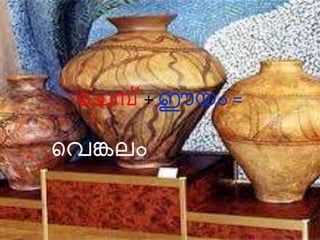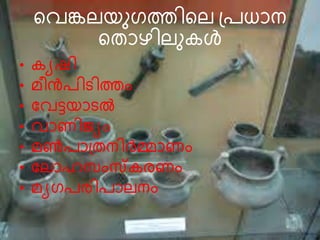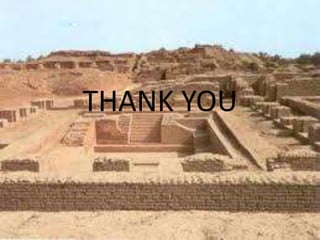1 of 11
Download to read offline

![Ó┤ĄÓĄåÓ┤ÖÓĄŹÓ┤ĢÓ┤▓Ó┤»ÓĄüÓ┤ŚÓ┤é
ŌĆókl-I-cWm├¤I kaq-l cq]h-XvI-c-
W-¯nv
sh┬”-e-bpK kwkvIm-cw.](https://image.slidesharecdn.com/welcome2-140917041954-phpapp02/85/Welcome-2-2-320.jpg)
![ŌĆó CuPn-]vXv, sak-s┬Ė-t┬½m-an-b, lmc-┬Ė,
ssN F┬Čn-h-bmWv {]ap-J-┬¦-fmb sh┬”-
e-bpK kwkvIm-c-┬¦├ä](https://image.slidesharecdn.com/welcome2-140917041954-phpapp02/85/Welcome-2-3-320.jpg)


![ŌĆó sh┬”-e┬»ns├ó Is-┬»├é kl-I-c-Wm-├¤I kaq-l-┬»ns├ó hnhn-[ taJ-e-I-fn├é am├ż-┬¦├ä
hcp¯n
ŌĆó Im├ĆjnI taJ-e-bn├é
ŌĆó hym]mc taJ-e-bn├é
ŌĆó km┬╝-┬»nI cwK┬»v
ŌĆó imkv{X-km-t┬”-XnI cwK┬»v
ŌĆó hm├Ć┬»mhnn-ab cwK┬»v
ŌĆó
XpS├Ć┬©](https://image.slidesharecdn.com/welcome2-140917041954-phpapp02/85/Welcome-2-6-320.jpg)
![ŌĆó sh┬”-e┬»ns├ó Is-┬»├é kl-I-c-Wm-├¤I kaq-l-┬»ns├ó hnhn-[ taJ-e-I-fn├é am├ż-┬¦├ä
hcp¯n
ŌĆó KXm-K-X-cw-K┬»v
ŌĆó Km├Ćln-I-cw-K┬»v
ŌĆó {]Xn-tcm[ taJ-e-bn├é
ŌĆó hnZym-`ymkw
ŌĆó hyhkmb taJ-e-bn├é](https://image.slidesharecdn.com/welcome2-140917041954-phpapp02/85/Welcome-2-7-320.jpg)
![ŌĆó kl-I-c-Wm-├¤I kaqlw F┬¦-s-sbms┬Ī?
tXmSp-I-fpsS Bhiyw IqSn h┬Č-t┬Ėm├ä hnhn[ P-hn-`m-K-┬¦├ä H┬Čn┬©p
tN├Ć┬Čv Ah n├Ć┬Įn┬Īm┬│ apt┬Čm┬½p h┬Čp
K-c-Po-hnX kwkvIm-c-hpw, I┬©-h-Shpw
km[--ssI-┬Įm-├ż-hy-h-├ś-bn├é n┬Čv ]W-┬»n-tebv┬Īv
sXmgn├é hn`-Pw ne-hn├é h┬ČXv
`c-W-hy-h-├ś-bpsS XpS┬Īw
FgpXn kq┬Żn-┬Ī-s┬Ė-Sp┬Č nb-a-┬¦├ä en]n, hmsam-gn,-
h-csamgnbn-tebv┬Īv](https://image.slidesharecdn.com/welcome2-140917041954-phpapp02/85/Welcome-2-8-320.jpg)
![ŌĆó kl-I-c-Wm-├¤I kaqlw F┬¦-s-sbms┬Ī?
ŌĆó sh┬”-e┬»ns├ó ]cn-an-Xn-I├ä kl-I-c-Wm-├¤I kaq-l-┬»nv am├żpIq┬½n
ŌĆó sN┬╝pw, Cubhpw Xmc-X-tay Zp├Ć_-e-amb teml-┬¦-fm-Wv.
ŌĆó anI┬© teml-]-Wn-┬Īm├Ć┬Īv am{Xta sh┬”-e-sa┬Č Iq┬½p-temlw Dm-┬Īm-
mIq
ŌĆó XpS├Ć┬Čv Ccp-┬╝ns├ó Ip-]nSn┬»┬»n-tebv┬Īv
kl-I-c-Wm-├¤I kaqlw sNs┬Č┬»n](https://image.slidesharecdn.com/welcome2-140917041954-phpapp02/85/Welcome-2-9-320.jpg)


Ad
Recommended
The Next Big Thing...Or Not: The Nintendo Wii Mini
The Next Big Thing...Or Not: The Nintendo Wii MiniMelissa Rosenow
╠²
The document analyzes the potential for the Nintendo Wii Mini to be widely adopted using Everett Rogers' diffusion of innovations theory. It finds the Wii Mini is lacking several key attributes that influence adoption, such as compatibility, trialability, and relative advantage. Specifically, it has limited backwards compatibility, few retail demonstration opportunities, and its value is questionable given its high price. Due to mistakes in marketing and targeting of laggards rather than early adopters, the Wii Mini will have difficulty progressing through the innovation-decision process and achieving widespread diffusion.Water the elixir of life
Water the elixir of lifeGayathri Devi V L
╠²
The document discusses water on Earth. It notes that liquid water exists naturally only on Earth, which is covered 2/3 by water and appears blue from space. Most (97%) of Earth's water is saline ocean water, while only 3% is freshwater and a small portion of that is easily accessible. Water exists in oceans, glaciers, the atmosphere, and underground aquifers. Rivers are an important source of surface freshwater, and some flow year-round while others are seasonal. Rainwater harvesting methods like recharge pits can help replenish underground water supplies and prevent depletion.Mountains
MountainsGayathri Devi V L
╠²
This presentation discusses different types of mountains. There are four main types: fold mountains, which are formed by the folding of tectonic plates; block mountains, which are formed by uplift due to faulting and have flat tops and steep sides; relict mountains, which are residual mountains formed by weathering processes that leave only resistant rocks; and volcanic mountains, which are formed when molten rock flows onto the surface through fissures caused by plate movement. Examples are given for each type, including the Himalayas for fold mountains, the Black Forest for block mountains, the Aravalli Ranges for relict mountains, and Mount Etna for volcanic mountains.Atmosphere
AtmosphereGayathri Devi V L
╠²
The document discusses the composition and structure of the Earth's atmosphere. It notes that the atmosphere is composed primarily of nitrogen, oxygen, and trace amounts of other gases, as well as varying amounts of water vapor and dust particles. It then describes the different layers of the atmosphere - the troposphere, stratosphere, mesosphere, and thermosphere - and how temperature varies with altitude through each layer. Finally, it discusses several atmospheric phenomena including air pollution, acid rain, the greenhouse effect, global warming, and ozone depletion.Identities
IdentitiesGayathri Devi V L
╠²
Priyanka.S submitted a document about mathematical identities for her optional subject of mathematics. The document defines 8 identities including the product of a sum and number, product of sums, square of a sum, product of differences, square of a difference, product of a sum and difference, sum and difference, cube of a sum, and cube of a difference. The document was submitted by Priyanka.S.Cheru punchiri
Cheru punchiriGayathri Devi V L
╠²
- The document discusses the life and works of writer F.N. Hmkpathi. He was born in 1933 in Idukki district of Kerala state in India.
- He worked in various fields including teaching, journalism, editing, and writing. He received several awards including Kerala Sahitya Akademi Award.
- Some of his notable works include short stories, novels, and plays. He is known for introducing realism and experimental techniques in Malayalam literature.
- The document provides details about his life and analyzes his works like stories, novels and plays which dealt with social issues and human relationships. It summarizes how one of his works "A Single Reed" portrayed theVrinda
VrindaGayathri Devi V L
╠²
This document discusses mixtures, which are formed by combining two or more components like soil, gold, saline water, and juice. It then outlines several techniques that can be used to separate mixtures, including filtration, distillation, fractional distillation, separating funnel, chromatography, and centrifugation. Each technique separates mixtures based on different properties of the components such as insolubility, volatility, boiling point, immiscibility, solubility, and density.Anu
AnuGayathri Devi V L
╠²
A simple pendulum consists of a bob suspended from a wire or string with negligible mass, with the length defined as the distance between the point of suspension and the center of the bob. The pendulum oscillates in a to-and-fro motion about a fixed point, with the equilibrium position being where the pendulum is at rest, and the amplitude being the maximum displacement of the bob from the equilibrium position.Saritha
SarithaGayathri Devi V L
╠²
This document discusses two main types of rainwater harvesting: surface rainwater harvesting which includes multi-storied cropping, mulching, bench terracing, contour cropping, and rainwater pits. The second type is roof top rainwater harvesting which collects rainwater from building roofs.Pooja
PoojaGayathri Devi V L
╠²
The document discusses the properties and examples of acids and alkalis. It defines acids as substances that produce hydrogen ions when dissolved in water, listing common acids like hydrochloric acid and nitric acid. Acids have properties such as a sour taste, ability to conduct electricity in solution, turning litmus red, and reacting with metals, carbonates, and bases. Alkalis are defined as metal oxides or hydroxides soluble in water, with examples including sodium hydroxide and potassium hydroxide. Alkalis have properties like a bitter taste, dissolving in water to produce hydroxide ions, turning litmus blue, and reacting with metals, ammonium salts, and acids.Shaijuppt
ShaijupptGayathri Devi V L
╠²
This document provides examples of how to use different tenses in English including simple present, past, and future, present and past continuous, present perfect, past perfect, and future perfect tenses. It explains when each tense is used, such as for habitual actions, historical events, possessions, conditional clauses, and reported speech. Examples are given for how to refer to past, present, and future time frames using these tenses.Welcome
WelcomeGayathri Devi V L
╠²
The document is a PowerPoint presentation about the Election Commission. It was submitted by Biju M.P. from the College of Teacher Education in Arkkkannoor. The presentation discusses the key roles and responsibilities of the Election Commission, which include preparing voter lists, supervising the election process, declaring election dates and results, fixing dates for nominations and vote counting, advising the president on elections, recognizing political parties and allocating symbols, implementing a code of conduct for parties, settling disputes, and scrutinizing candidate expenses.Welcome
WelcomeGayathri Devi V L
╠²
The document is a PowerPoint presentation about the Election Commission. It was submitted by Biju M.P. from the College of Teacher Education in Arkkkannoor. The presentation discusses the key roles and responsibilities of the Election Commission, which include preparing voter lists, supervising the election process, declaring election dates and results, fixing dates for filing nominations and vote counting, giving advice to the president and governors on elections, recognizing and allocating symbols to political parties, preparing and implementing a code of conduct for parties, and settling disputes and scrutinizing candidates' election expenses.Presentation1
Presentation1Gayathri Devi V L
╠²
This document defines acids and alkalis and provides their key properties. It states that acids produce hydrogen ions when dissolved in water and lists common acids like hydrochloric acid. It also notes that acids have a sour taste, turn litmus red, and have a pH below 7. Alkalis are defined as metal oxides or hydroxides soluble in water, with examples given. Alkalis are described as having a bitter taste, turning litmus blue, and having a pH above 7. The document outlines how both acids and alkalis react with other substances.Kineticandpotentialenergy
KineticandpotentialenergyGayathri Devi V L
╠²
This document discusses different types of energy including kinetic energy and potential energy. Kinetic energy is the energy of motion and is calculated using the formula KE=1/2mv^2, where m is mass and v is velocity. Potential energy is energy due to an object's position or state and is calculated using the formula PE=mgh, where m is mass, g is the acceleration due to gravity, and h is height. Examples are provided to demonstrate calculating the kinetic energy of a moving car and the potential energy of a rock located above the ground.Presentationdivya 140826061147-phpapp01
Presentationdivya 140826061147-phpapp01Gayathri Devi V L
╠²
The document appears to detail interactions and protocols related to a specific system or framework, referencing numerous technical components. It highlights functions and processes, possibly within a computational or network context. The text includes terminology indicating a focus on operational procedures and configurations.Presentationdivya 140826061147-phpapp01
Presentationdivya 140826061147-phpapp01Gayathri Devi V L
╠²
Life's meaning lies in human relationships. People's life experiences are reflected in their works. Works convey the essence through artistic expressions. Living virtuously in faith is the ideal way.Deepthi
DeepthiGayathri Devi V L
╠²
An internal force is a force acting within a body, such as the particles holding a baseball together. An external force acts from outside the body, like a baseball bat hitting a baseball or the friction from car wheels on the ground. Internal forces are exerted by one part of a structure on another part, while external forces come from outside the structure.More Related Content
More from Gayathri Devi V L (12)
Vrinda
VrindaGayathri Devi V L
╠²
This document discusses mixtures, which are formed by combining two or more components like soil, gold, saline water, and juice. It then outlines several techniques that can be used to separate mixtures, including filtration, distillation, fractional distillation, separating funnel, chromatography, and centrifugation. Each technique separates mixtures based on different properties of the components such as insolubility, volatility, boiling point, immiscibility, solubility, and density.Anu
AnuGayathri Devi V L
╠²
A simple pendulum consists of a bob suspended from a wire or string with negligible mass, with the length defined as the distance between the point of suspension and the center of the bob. The pendulum oscillates in a to-and-fro motion about a fixed point, with the equilibrium position being where the pendulum is at rest, and the amplitude being the maximum displacement of the bob from the equilibrium position.Saritha
SarithaGayathri Devi V L
╠²
This document discusses two main types of rainwater harvesting: surface rainwater harvesting which includes multi-storied cropping, mulching, bench terracing, contour cropping, and rainwater pits. The second type is roof top rainwater harvesting which collects rainwater from building roofs.Pooja
PoojaGayathri Devi V L
╠²
The document discusses the properties and examples of acids and alkalis. It defines acids as substances that produce hydrogen ions when dissolved in water, listing common acids like hydrochloric acid and nitric acid. Acids have properties such as a sour taste, ability to conduct electricity in solution, turning litmus red, and reacting with metals, carbonates, and bases. Alkalis are defined as metal oxides or hydroxides soluble in water, with examples including sodium hydroxide and potassium hydroxide. Alkalis have properties like a bitter taste, dissolving in water to produce hydroxide ions, turning litmus blue, and reacting with metals, ammonium salts, and acids.Shaijuppt
ShaijupptGayathri Devi V L
╠²
This document provides examples of how to use different tenses in English including simple present, past, and future, present and past continuous, present perfect, past perfect, and future perfect tenses. It explains when each tense is used, such as for habitual actions, historical events, possessions, conditional clauses, and reported speech. Examples are given for how to refer to past, present, and future time frames using these tenses.Welcome
WelcomeGayathri Devi V L
╠²
The document is a PowerPoint presentation about the Election Commission. It was submitted by Biju M.P. from the College of Teacher Education in Arkkkannoor. The presentation discusses the key roles and responsibilities of the Election Commission, which include preparing voter lists, supervising the election process, declaring election dates and results, fixing dates for nominations and vote counting, advising the president on elections, recognizing political parties and allocating symbols, implementing a code of conduct for parties, settling disputes, and scrutinizing candidate expenses.Welcome
WelcomeGayathri Devi V L
╠²
The document is a PowerPoint presentation about the Election Commission. It was submitted by Biju M.P. from the College of Teacher Education in Arkkkannoor. The presentation discusses the key roles and responsibilities of the Election Commission, which include preparing voter lists, supervising the election process, declaring election dates and results, fixing dates for filing nominations and vote counting, giving advice to the president and governors on elections, recognizing and allocating symbols to political parties, preparing and implementing a code of conduct for parties, and settling disputes and scrutinizing candidates' election expenses.Presentation1
Presentation1Gayathri Devi V L
╠²
This document defines acids and alkalis and provides their key properties. It states that acids produce hydrogen ions when dissolved in water and lists common acids like hydrochloric acid. It also notes that acids have a sour taste, turn litmus red, and have a pH below 7. Alkalis are defined as metal oxides or hydroxides soluble in water, with examples given. Alkalis are described as having a bitter taste, turning litmus blue, and having a pH above 7. The document outlines how both acids and alkalis react with other substances.Kineticandpotentialenergy
KineticandpotentialenergyGayathri Devi V L
╠²
This document discusses different types of energy including kinetic energy and potential energy. Kinetic energy is the energy of motion and is calculated using the formula KE=1/2mv^2, where m is mass and v is velocity. Potential energy is energy due to an object's position or state and is calculated using the formula PE=mgh, where m is mass, g is the acceleration due to gravity, and h is height. Examples are provided to demonstrate calculating the kinetic energy of a moving car and the potential energy of a rock located above the ground.Presentationdivya 140826061147-phpapp01
Presentationdivya 140826061147-phpapp01Gayathri Devi V L
╠²
The document appears to detail interactions and protocols related to a specific system or framework, referencing numerous technical components. It highlights functions and processes, possibly within a computational or network context. The text includes terminology indicating a focus on operational procedures and configurations.Presentationdivya 140826061147-phpapp01
Presentationdivya 140826061147-phpapp01Gayathri Devi V L
╠²
Life's meaning lies in human relationships. People's life experiences are reflected in their works. Works convey the essence through artistic expressions. Living virtuously in faith is the ideal way.Deepthi
DeepthiGayathri Devi V L
╠²
An internal force is a force acting within a body, such as the particles holding a baseball together. An external force acts from outside the body, like a baseball bat hitting a baseball or the friction from car wheels on the ground. Internal forces are exerted by one part of a structure on another part, while external forces come from outside the structure.Welcome (2)
- 1. WELCOME
- 2. Ó┤ĄÓĄåÓ┤ÖÓĄŹÓ┤ĢÓ┤▓Ó┤»ÓĄüÓ┤ŚÓ┤é ŌĆókl-I-cWm├¤I kaq-l cq]h-XvI-c- W-┬»nv sh┬”-e-bpK kwkvIm-cw.
- 3. ŌĆó CuPn-]vXv, sak-s┬Ė-t┬½m-an-b, lmc-┬Ė, ssN F┬Čn-h-bmWv {]ap-J-┬¦-fmb sh┬”- e-bpK kwkvIm-c-┬¦├ä
- 4. Ó┤ĄÓĄåÓ┤«ÓĄŹÓ┤¬ÓĄŹ + Ó┤łÓ┤»Ó┤é = Ó┤ĄÓĄåÓ┤ÖÓĄŹÓ┤ĢÓ┤▓Ó┤é
- 5. Ó┤ĄÓĄåÓ┤ÖÓĄŹÓ┤ĢÓ┤▓Ó┤»ÓĄüÓ┤ŚÓ┤żÓĄŹÓ┤żÓ┤┐Ó┤ĄÓ┤▓ Ó┤¬ÓĄŹÓ┤░Ó┤¦Ó┤ŠÓ┤© Ó┤Ą Ó┤ŠÓ┤┤Ó┤┐Ó┤▓ÓĄüÓ┤ĢÓĄŠ ŌĆó Ó┤ĢÓ┤»Ó┤ĘÓ┤┐ ŌĆó Ó┤«ÓĄĆÓĄ╗Ó┤░Ó┤┐Ó┤¤Ó┤┐Ó┤żÓĄŹÓ┤żÓ┤é ŌĆó Ó┤ĄÓĄåÓ┤¤ÓĄŹÓ┤¤Ó┤»Ó┤ŠÓ┤¤ÓĄĮ ŌĆó ÓĄåÓ┤ŠÓ┤ŻÓ┤┐Ó┤£ÓĄŹÓ┤»Ó┤é ŌĆó Ó┤«ÓĄ║Ó┤░Ó┤ŠÓ┤¬ÓĄŹ Ó┤©Ó┤┐ÓĄ╝Ó┤«ÓĄŹÓ┤«Ó┤ŠÓ┤ŻÓ┤é ŌĆó Ó┤ĄÓ┤▓Ó┤ŠÓ┤╣Ó┤ĖÓ┤éÓ┤ĖÓĄŹÓ┤ĢÓ┤░Ó┤ŻÓ┤é ŌĆó Ó┤«Ó┤»Ó┤ŚÓ┤░Ó┤░Ó┤┐Ó┤░Ó┤ŠÓ┤▓Ó┤©Ó┤é
- 6. ŌĆó sh┬”-e┬»ns├ó Is-┬»├é kl-I-c-Wm-├¤I kaq-l-┬»ns├ó hnhn-[ taJ-e-I-fn├é am├ż-┬¦├ä hcp┬»n ŌĆó Im├ĆjnI taJ-e-bn├é ŌĆó hym]mc taJ-e-bn├é ŌĆó km┬╝-┬»nI cwK┬»v ŌĆó imkv{X-km-t┬”-XnI cwK┬»v ŌĆó hm├Ć┬»mhnn-ab cwK┬»v ŌĆó XpS├Ć┬©
- 7. ŌĆó sh┬”-e┬»ns├ó Is-┬»├é kl-I-c-Wm-├¤I kaq-l-┬»ns├ó hnhn-[ taJ-e-I-fn├é am├ż-┬¦├ä hcp┬»n ŌĆó KXm-K-X-cw-K┬»v ŌĆó Km├Ćln-I-cw-K┬»v ŌĆó {]Xn-tcm[ taJ-e-bn├é ŌĆó hnZym-`ymkw ŌĆó hyhkmb taJ-e-bn├é
- 8. ŌĆó kl-I-c-Wm-├¤I kaqlw F┬¦-s-sbms┬Ī? tXmSp-I-fpsS Bhiyw IqSn h┬Č-t┬Ėm├ä hnhn[ P-hn-`m-K-┬¦├ä H┬Čn┬©p tN├Ć┬Čv Ah n├Ć┬Įn┬Īm┬│ apt┬Čm┬½p h┬Čp K-c-Po-hnX kwkvIm-c-hpw, I┬©-h-Shpw km[--ssI-┬Įm-├ż-hy-h-├ś-bn├é n┬Čv ]W-┬»n-tebv┬Īv sXmgn├é hn`-Pw ne-hn├é h┬ČXv `c-W-hy-h-├ś-bpsS XpS┬Īw FgpXn kq┬Żn-┬Ī-s┬Ė-Sp┬Č nb-a-┬¦├ä en]n, hmsam-gn,- h-csamgnbn-tebv┬Īv
- 9. ŌĆó kl-I-c-Wm-├¤I kaqlw F┬¦-s-sbms┬Ī? ŌĆó sh┬”-e┬»ns├ó ]cn-an-Xn-I├ä kl-I-c-Wm-├¤I kaq-l-┬»nv am├żpIq┬½n ŌĆó sN┬╝pw, Cubhpw Xmc-X-tay Zp├Ć_-e-amb teml-┬¦-fm-Wv. ŌĆó anI┬© teml-]-Wn-┬Īm├Ć┬Īv am{Xta sh┬”-e-sa┬Č Iq┬½p-temlw Dm-┬Īm- mIq ŌĆó XpS├Ć┬Čv Ccp-┬╝ns├ó Ip-]nSn┬»┬»n-tebv┬Īv kl-I-c-Wm-├¤I kaqlw sNs┬Č┬»n
- 10. THANK YOU
- 11. ŌĆó END
